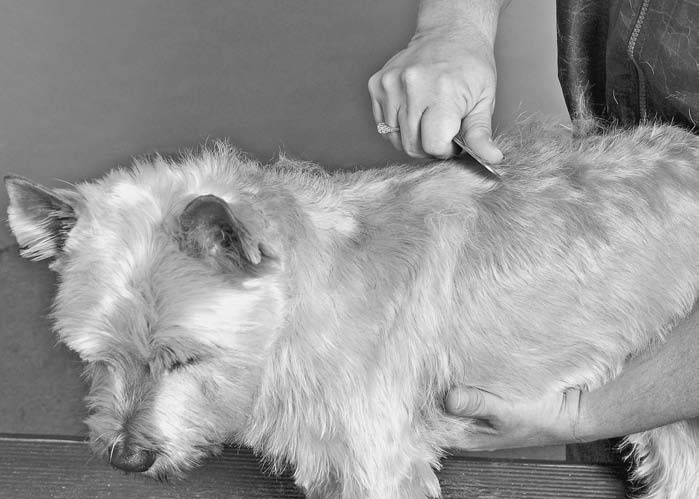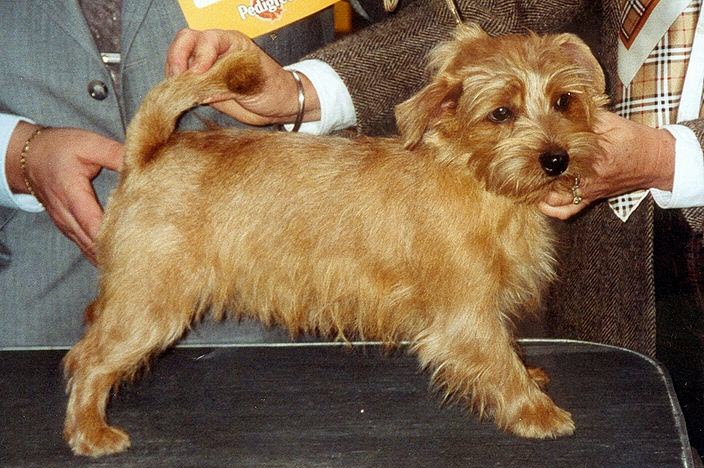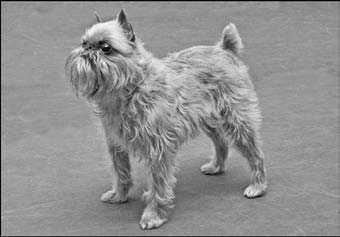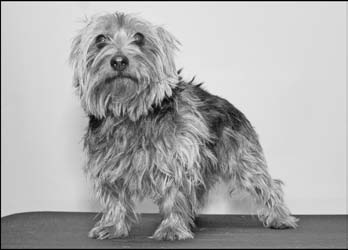- Discovering the stripped breeds
- Finding out how to brush stripped breeds’ coats
- Stripping a dog’s coat
- Taking the time to prepare for a stripped-breed show
As it pertains to dogs, stripping in a nutshell involves removing the dead undercoat from the rest of a dog’s coat. Most stripped breeds are terriers and almost all are wire-haired dogs, which makes stripping the old-growth hair a necessity. Otherwise your dog’s coat will look dull and wooly.
You can strip a dog’s coat by using either a stripping knife, shedding blade, or even your fingers. Stripping a canine coat is time consuming; it can take hours (if you strip your dog’s entire coat all at once) or days (if you choose to roll the coat, or strip it in sections).
You’re probably wondering why you should bother stripping a dog’s coat when you can much more easily clip it in a few minutes. After all, you can use clippers on the dog and get pretty much the same results, can’t you? Well, not exactly. Using clippers on a stripped-breed dog tends to make the hair softer and less consistent with the coat type recommended by the standards for stripped breeds. If adhering to the breed standard is a big deal for you either because you’re showing your dog or because you want your dog to look right, then you must find out how to strip your dog properly. Lucky for you, this chapter explains how to strip dog breeds that traditionally are stripped. Arguably many of these dogs can fall into the clipped breeds (see Chapter
Beautifying the Stripped Breeds), so after reading this chapter, you can decide whether you want to strip or clip your dog.
Introducing the Stripped Breeds
Most of the dog breeds that need to be stripped are terriers, although a few other breeds fall into the stripped-breed category. In fact, many dogs with two-ply or double coats can be stripped in much the same way when they’re blowing coat, or shedding their undercoats. Dogs that traditionally are stripped include:
- Affenpinscher
- Airedale Terrier
- Australian Terrier
- Border Terrier
- Bouvier de Flandres
- Brussels Griffon
- Cairn Terrier
- Wirehaired Dachshund
- Dandie Dinmont Terrier
- Wirehaired Fox Terrier
- German Wirehaired Pointer
- Giant Schnauzer
- Irish Terrier
- Irish Wolfhound
- Jack Russell Terrier
| - Lakeland Terrier
- Miniature Schnauzer
- Norfolk Terrier
- Norwich Terrier
- Otterhound
- Parson Russell Terrier
- Petit Basset Griffon Vendéen
- Scottish Deerhound
- Scottish Terrier
- Sealyham Terrier
- Smooth Fox Terrier
- Standard Schnauzer
- Welsh Terrier
- West Highland White Terrier
- Wirehaired Pointing Griffon
|
Can’t I pay someone to do this for me?Stripping a dog is a daunting task, which is why you may be thinking, “Hey, that’s what professional groomers are for.” Well, I have bad news for you. Many professional groomers simply don’t do stripping. And if they do, you’re bound to pay a hefty amount of money, because it’s a really time-consuming task. Instead, many pro groomers are more likely to clip your stripped-breed dog. If clipping isn’t something that you want, you must either ask around for a groomer who will strip your dog and pay the money or learn to do it yourself. |
Figure 12-1: Brussels Griffons (a) and Miniature Schnauzers (b) are two of the breeds with coats that need to be stripped.
Brushing
Brushing a stripped-breed or wire-haired dog isn’t necessarily a big deal. You need to brush him at least twice a week to be certain his coat is in top condition.
The basics
Brushing your wirehair in preparation to be stripped is different than the method used for clipped-breed dogs in Chapter
Beautifying the Stripped Breeds, because the coats are maintained differently. Here’s what you do:
1. Check for tangles or mats and remove them using detangler solution and a medium-toothed comb.
If this method doesn’t work, try using a mat splitter or mat rake (see Chapter Caring for Your Canine’s Teeth, Toes, Ears, Face, and Ahem, Other Areas for specific mat removing instructions).
2. Backbrush your dog’s coat, or brush against the lay of the hair, first using a slicker brush and then again with a medium- or coarse-toothed comb.
3. Brush your dog’s coat with the lay of the hair using a slicker brush.
Also use a slicker brush on any thick hairs, such as those along the legs (like Airedale Terriers and other similar breeds may have).
4. Check for fleas by running a flea comb over your dog’s entire coat.
Knowing when it’s time to strip
Maybe your dog is looking a little ratty, or maybe your dog’s hair is looking a little long. Regardless, you can always tell that he needs his coat stripped when you see the hair forming in little cotton ball–like clumps. Try gently plucking the fur by hand, and if it comes out easily, you know it’s time to strip your dog’s coat. Here’s another way to tell: The coat is supposed to lay tightly against the dog’s body (like a jacket). When it doesn’t, it’s time to strip it.
Most breeders and show people fully strip their dogs twice a year, but if you decide to roll your dog’s coat (see the “Rolling the coat” section later in this chapter), you then work on the stripping process every time you brush your dog.
Bathing
Bathing is important for stripped-breed (or wire-haired) dogs. Although they don’t need quite as much bathing as clipped-breed dogs (see Chapter
Beautifying the Stripped Breeds), a bath once or twice a month is a good idea to keep your dog looking and smelling great.
The prebath strip
Before you pour your dog’s tepid bath water, you’re going to have to strip your dog’s coat, if it needs it. As you find out from the “Bathing basics” section, you first have to brush and comb out your dog’s coat to remove any tangles and get your dog’s hair ready for a bath. In addition to brushing and combing out your dog before his bath, stripped-breed dogs also need a prebath stripping to remove the loose hairs. Doing so actually makes bathing your dog much easier.
Start with either a stripping knife, a shedding blade, or even your hands to hand strip (or pluck) your dog’s coat. Removing the loose hairs guarantees a cleaner dog and less hair going down the drain. You’ll find out exactly how to strip a dog in the “Stripping Your Dog” section later in this chapter.
Bathing basics
Bathing a stripped breed isn’t much different than bathing any other breed. Here’s how:
1. Wet down your dog thoroughly with tepid water in a tub that’s an appropriate size for your breed of dog.
Make sure that your dog’s coat gets wet all the way down to the skin, which should be fairly easy if you’ve maintained a good stripped coat.
2. Using a pH-balanced dog shampoo, thoroughly lather up your dog’s entire coat except around the face and eyes — which you must do separately with a wet cloth to help keep the shampoo out of his eyes.
3. Thoroughly rinse your dog’s coat.
Soap is a dirt attractant even for a wire-haired breed, so be sure to rinse your dog’s coat carefully and thoroughly down to the skin.
4. Apply an excellent pH-balanced dog coat conditioner that prevents tangles and keeps the coat from drying out.
Make sure you use a conditioner that doesn’t make the hair too soft. Remember: Wire-haired dogs are supposed to have harsh coats.
5. Repeat Step 3, squeeze out excess water, and rinse again.
Remember
When rinsing your dog’s coat, be sure to remove all soap and conditioner residues. If you don’t rinse your dog’s coat, it’ll get dirty quicker and it may leave the wrong feel for a harsh (stripped) coat.
6. Dry your dog’s coat thoroughly before stripping.
You can use a doggie blow-dryer or one intended for human use that has a “no-heat” setting.
Stripping Your Dog
If you’re wondering why you should bother stripping your dog’s coat when he will lose his undercoat on his own, remember that he also will look ratty if you don’t help remove it (see Figure 12-2). Besides, an unstripped coat can be uncomfortable, because that much loose hair can easily form tangles or mats if it isn’t stripped.
Figure 12-2: Check out this pooch’s coat before stripping (a) and after stripping (b) — big difference!
You can strip a dog’s coat using either a stripping knife, a shedding blade, or just your fingers, and one of these two methods:
– Taking the coat down: This method removes all the loose hair on the dog’s body at one time.
– Rolling: This method removes a little bit of the loose coat in sections and not all at once. Rolling the coat means stripping it in one section and then the next. Although easier and less time consuming (in one session, anyway), rolling stretches out the time required to work your stripped breed’s entire coat into show condition (think a half year to a year).
Using a stripping knife
Probably the easiest way to strip a dog’s coat — that yields pretty good results — is stripping it with a stripping knife. Stripping knives are not truly knives and should never be sharp enough to cut or otherwise injure the person using it. Instead a stripping knife looks something like a putty knife that a plumber might use, except it has short teeth on one side.
Using a stripping knife is pretty simple. Run the knife through a bit of your dog’s hair by grasping some of the hair between your thumb (the one on the hand in which you’re holding the knife) and the knife blade (see Figure 12-3) and then pulling the knife away from your dog’s body and in the direction of the hair growth. Don’t hold the hair too firmly, or you end up yanking out too much good hair. Just pull out the loose hairs. Repeat this step throughout your dog’s coat.
Figure 12-3: Using a stripping knife.
Remember
The stripping knife doesn’t work as well as hand stripping, but if you’re short on time or have a big dog, it does a pretty good job. Remember, time is relative here. Stripping with a stripping knife still takes a lot of time, but because it takes more hair out than hand stripping, it’s faster.
Using a shedding blade
Another tool in your coat-stripping arsenal is a shedding blade. Using one is not as precise as a stripping knife, but if you have a big job of getting rid of a lot of hair all at once, the shedding blade can help.
Shedding blades usually are large blades that can be held in a folded position or straight. You basically drag the small teeth of the blade over the dog, and they pull out the hair onto the floor. Be careful not to scrape your dog’s skin with the blade!
Tip
When you have a big job (a big dog, a lot of hair, or both), use the shedding blade on the dog first, and then finish up with the stripping knife.
Hand stripping
Almost all groomers agree that the best stripping is done with your bare hands, because it’s more precise. Known as hand stripping, or plucking, when using this method, you go over your dog’s coat slowly and look for any loose hairs or undercoat that looks like little cotton tufts. With your thumb and forefinger, you grasp the tuft and gently but firmly pull out (the direction you pull or the amount of hair you pull at one time doesn’t matter). Repeat as needed.
Rolling the coat
Rolling is a term used by groomers to describe a certain type of stripping. It’s generally done by hand, but it can be done using a knife. You start on one section and strip or pluck that section on one day. Then the next day or in a few days, you strip another section. Because you usually move from one section to the next in a pattern that ultimately covers your dog’s entire body, it’s called rolling.
One positive side effect of rolling is that you strip only a little bit of your dog’s coat at one time rather than taking hours to strip the entire dog. The negative side of rolling is that whenever you’re planning to show your dog within a few months, you’re out of luck, because rolling by itself can take six months or more to work a coat into show quality. However, after you get your dog’s coat into show shape, rolling can keep it in show shape all the time.
Determining whether stripping is cruelSome groomers are of the opinion that hand stripping or hand plucking a coat causes a lot of discomfort for the dog, and they simply prefer to clip rather than strip their dogs. To be honest with you, some dogs do have problems with the procedure, probably because the tufts of dead hair often catch and pull on live hairs. I’ve noticed that this coat pulling occurs more often with hand-plucking than it does when a shedding blade or a stripping knife is used. If your dog tends to have sensitive skin, you need to use one or the other of these implements to facilitate the stripping process. |
Tip
Dog owners who show stripped-breed dogs generally strip their dogs’ entire coats and then use rolling to maintain them.
Preparing for Show
Preparing a stripped dog for show literally requires you to work months in advance of the show. If you own a dog who simply must be stripped, you can expect to strip him at least two months before the show or begin rolling (see previous section) the dog’s coat at least six months ahead of the show.
Remember
When showing your dog, understanding the breed standard and the correct coat type your dog should be wearing, if you will, are essential. A good place to look for breed standards is on the Internet at www.akc.org.
The basic coat care that you have to perform to prepare a stripped breed for show includes
- Trimming your dog’s toenails
- Brushing out your dog
- Removing any mats
- Stripping your dog’s coat prior to bathing
- Bathing your dog
- Drying your dog
- Brushing out your dog
- Stripping your dog
- Clipping stray hairs and keeping a clean line if allowed by the breed standard
- Using coat dressing whenever appropriate
Remember
In between shows, you need to hand roll your dog’s coat to keep it looking 100 percent. Every time you groom your dog, do the following:
1. Starting at your dog’s head and working down the head and neck, gently pluck out (with your hand) any hairs that ruin the clean line.
2. Moving on to the back and sides, pluck out any stray hair you find there.
3. Look and feel down your dog’s front legs and chest, plucking any stray hairs.
4. Search for and pluck stray hairs that dogs usually lose along their rear ends and the backs of their legs.
5. Check along the belly and abdomen for stray hairs and pluck them carefully. It can be tender there!
6. Look along the base of the tail and along the tail itself for any areas that need to be plucked.
These instructions on hand rolling a coat are simplified. The truth is, finding a pro who can show you how to strip and then roll a coat is the best approach. After you learn how, you’ll get into the routine pretty quickly.
by Margaret H.Bonham











